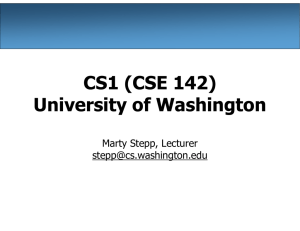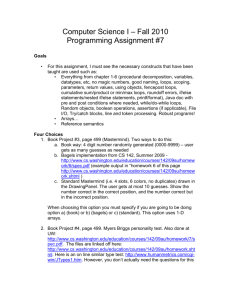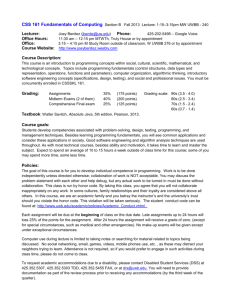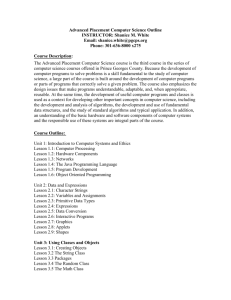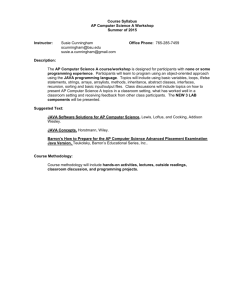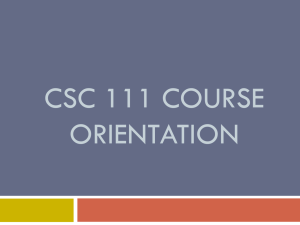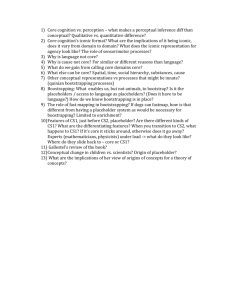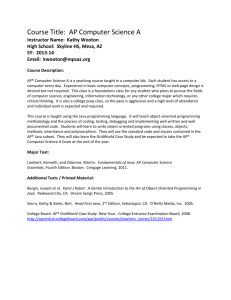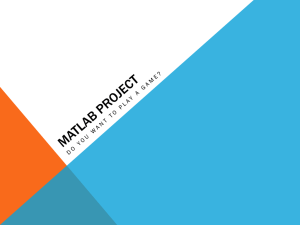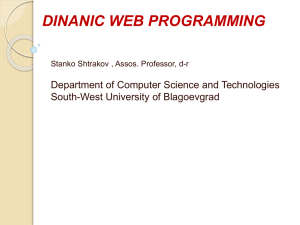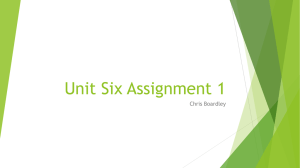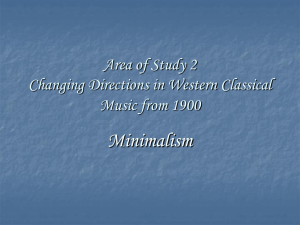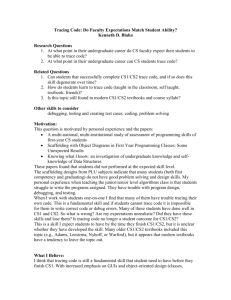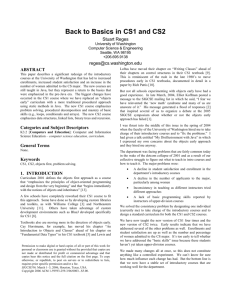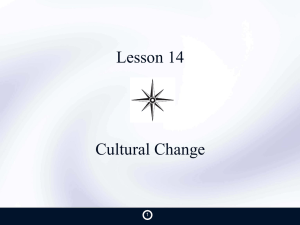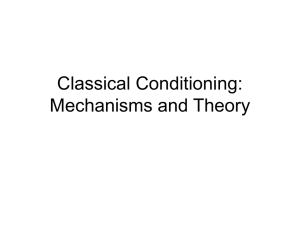CSE 142 Python Slides - University of Washington
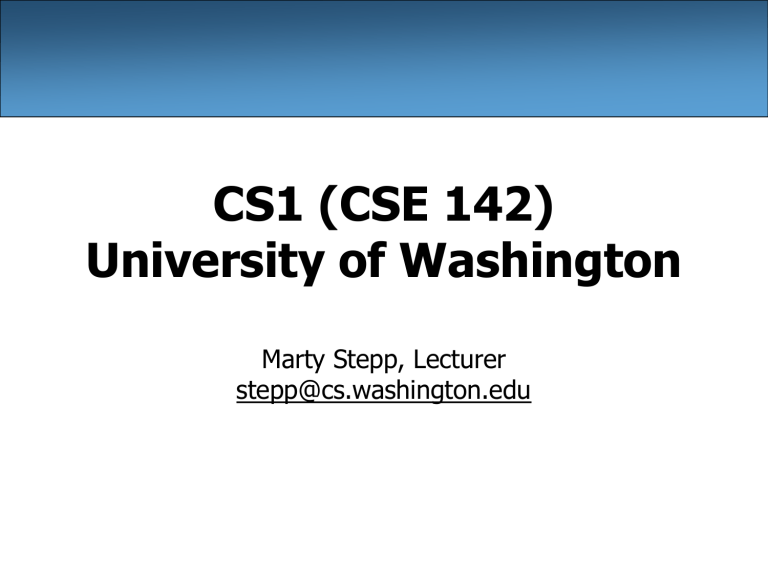
CS1 (CSE 142)
University of Washington
Marty Stepp, Lecturer stepp@cs.washington.edu
Our CS1 course principles
• Procedural
– use objects early, define classes late
– early focus on procedural decomposition into methods
• "Back to Basics"
– minimize use of scaffolding, pre-written complex code
– de-emphasize fancy graphics and output
– focus on algorithmic thinking and problem solving
• challenging, highly structured course
– assignments and exams: difficult but well-specified, predictable
– strict grading scale
– lots of help available (lab hours, section, book, email, msg.board)
2
Procedural? Really??
Classic procedural tasks are tough!
• Selection with if/else
– nesting, most closely nested rule
– Are these 3 ints consecutive? What triangle do these points represent?
– boolean logic: De Morgan's Law, flags, passing/returning boolean
• Loops
– definite vs. indefinite loops
– loop invariants and logical assertions
– fencepost and sentinel problems
• Parameters/return
– students do not understand either until after lots of practice
• Arrays
– shifting elements
– using arrays for counting and tallying
– unfilled arrays as lists; inserting and removing
– arrays as parameters (references)
3
Why Java?
• Why not C/C++ or Pascal?
– C[++] makes too many simple things hard (strings, memory, .h files, pointers, no objects, bad type system, limited libraries)
– Pascal would be fine for some tasks, but worse for OOP and is no longer an active "real world" language being used
– Java gives us some nice things that the others don't (collections,
I/O abstractions, good community and software support, etc.)
• Why not Python, Ruby, etc.?
– industry demand for Java
– proliferation of resources, materials, libraries
– easier transition to upper-division courses
4
Course structure
• lectures
– "sage on the stage" (with lots of questions)
• TA discussion sections
– 1 per week; 50 minutes
– led by undergrad TAs
– each comes with a problem set, syntax cheat sheet, solution key
• closed labs
– new feature for Spring 2010
– optional weekly 80-minute lab for 1 credit ("CSE 190")
5
Textbook
•
Building Java Programs
, 2nd edition
( buildingjavaprograms.com
)
– new chapters: implementing collections linked lists, binary trees
– improved: proc. design, boolean logic, arrays, OOP, inheritance
– new end-of-chapter exercises geared at our labs / TA sections
• textbook as central hub of course
– weekly written problems (due in section)
– tight integration between lectures and book
– case studies similar to weekly assignments
– end-of-chapter problems solved in lab/section
– book as reference on our open-book exams
– same book for CS1 and CS2
– resources available on book web site
6
Grading and assessment
• homework 45%, midterm 20%, final 30%, participation 5%
• homework assignments as focal point of course
– approximately one assignment per week; 60-100 lines of code
– graded 50/50 on "external" and "internal" correctness (style)
– detailed problem descriptions
– vague solution descriptions (not, "implement this interface")
– provide testing materials (expected outputs; unit tests)
7
Weeks 1-2
• Week 1: Basic Java, procedural programming (Ch. 1)
– static methods, println
– lecture programs: print repeated text figures
– homework: "cumulative" song (12 days of xmas)
• Week 2: Data and definite loops (Ch. 2)
– expressions, variables, types, scope, constants
– for loops (including nested loops)
– lecture programs: print patterns of text
– homework: print a patterned figure (rocket; space needle; book)
8
Weeks 3-4
• Week 3: Parameterization (Ch. 3; Supplement 3G)
– 2D graphics (as killer example for parameterization)
• instructor-provided DrawingPanel class
– lecture programs: draw cars, pyramids, projectiles, etc.
– homework: draw a patterned graphical figure or optical illusion
• Week 4: Data/control flow; selection (Ch. 4)
– return
– if/else
– interactive programs with Scanner
– lecture program: compute TA salaries; body mass index
– homework: SAT/ACT scores/admissions; Grades; birthdays
9
Student creativity
• Creative song verses
• ASCII art contest
• Doodle contest
• Haiku poems
• Mad lib creation
• Personality test
• Critter Husky competition
10
Facebook application
• FB app created by former TA/instructor Victoria Kirst
• students post creative homework submissions
• other students and FB friends can vote on favorites
• an excellent advertisement for CSE 142!
11
Weeks 5-6
• Week 5: logic and indefinite loops (Ch. 5)
– boolean, logical assertions
– while loops, random numbers
– fencepost and sentinel problems
– lecture programs: roll dice, roulette, math tutor
– homework: number guessing game; random walk; hangman
• Week 6: midterm
– exam cramming as an opportunity for learning
12
Weeks 7-8
• Week 7: File processing (Ch. 6)
– Scanner , File , PrintStream
– lecture programs: process IMDb data
– homework: baby name graph; mad libs
• Week 8: Arrays (Ch. 7)
– lecture programs: midterm score tally; Benford's Law
– homework: Myers-Briggs personality test; DNA; Bagels game
13
Weeks 9-10
• Week 9: Classes and objects (Ch. 8)
– fields, methods, constructors, encapsulation
– lecture programs: Point class; Date class
– homework: Critters (2D OOP virtual world)
• Week 10: Inheritance/interfaces (Ch. 9); Final exam
– not tested via homework (exam only)
14
jGRASP
• decreased emphasis on bulky IDEs (e.g. Eclipse, NetBeans)
• jGRASP
– simple, basic
– runs on Win/Mac/Linux
– excellent debugger
– data structure visualizations
– interactions pane
– soon: JUnit
– no auto-completion
– no error underlining
15
TAs and sections
• weekly meetings w/ instructor
– what to teach in section
– common student issues, questions
• "head TA" role
• TA coordinators
– weekly training
• "community meetings"
16
Getting help
• support resources for students
– lecture programs very similar to assignment
• Example: Body Mass Index (BMI) program
– screen-cast videos and slides available for each lecture
– tight integration with textbook chapter and case study
– TA section materials directly relate to assignment
– Introductory Programming Lab ("IPL") staffed by TAs
17
Lab hours ("IPL")
• computer lab open 6-7 days per week, ~ noon - 9pm
– contrast between office hours and IPL hours
• staffed by undergrad TAs to answer homework questions
– TAs are given training to help understand how much help to give!
• TA-written queue/help management web site
• lists of common questions ( FAQs )
18
Closed lab sessions
• lab handouts for weekly 80-minute labs publicly available
• read/understand, debug/improve, and write code
• tight integration with textbook and course
19
Style guidelines
• "internal correctness" (style) graded strictly, weighted heavily
– 50% of homework grade
– Why?
• resources to students
– online style guidelines, examples
– detailed feedback from grader
– warnings ("minus-0")
20
Grade-It
• web-based software for grading homework assignments
– turnin; scoresheets; annotations; scripts; publishing; data/stats analysis; consistency checks; TA management
21
Academic integrity
• individual homework assignments (not pairs)
• web software to check for similarity using MOSS
22
Practice-It
• web-based software for practicing small Java coding problems
– how it's used in our course; current features/development
23
Other tools and resources
• Output comparison (diff) tool
• Indentation tool
• Grading gripe submission form
• optional sessions
– Python programming (also CS2 )
– CS " exploration sessions "
• " CS is Cool Stuff " blog
• future: Twitter , Share-It
24
Conclusion
• (almost) everything we use is available online
– http://www.cs.washington.edu/142/
– http://www.cs.washington.edu/143/
– http://www.cs.washington.edu/homes/reges/ctc/
– http://www.buildingjavaprograms.com/
– assignment/lab/section solutions available to instructors
– other past assignment specs and ideas (with solutions) available
– testing/grading scripts, grading criteria
– past exams, test bank
– comprehensive lecture slides and notes for CS1 and CS2
• goal: integrated course "ecosystem", course-in-a-box
25
